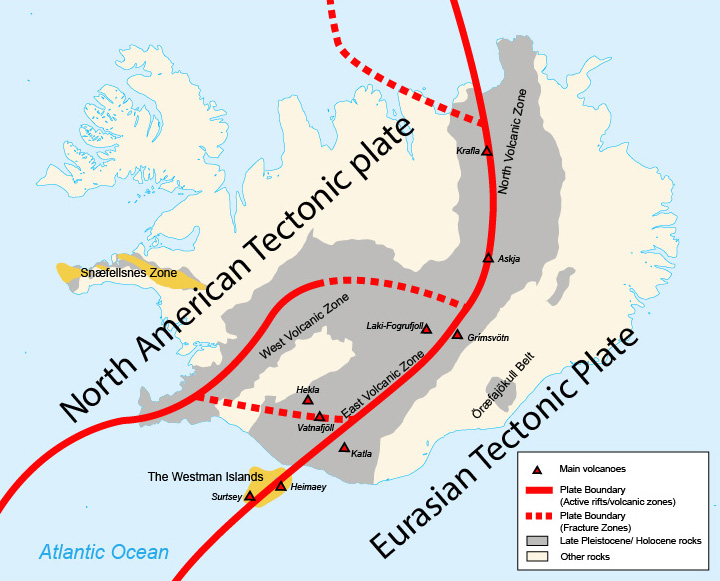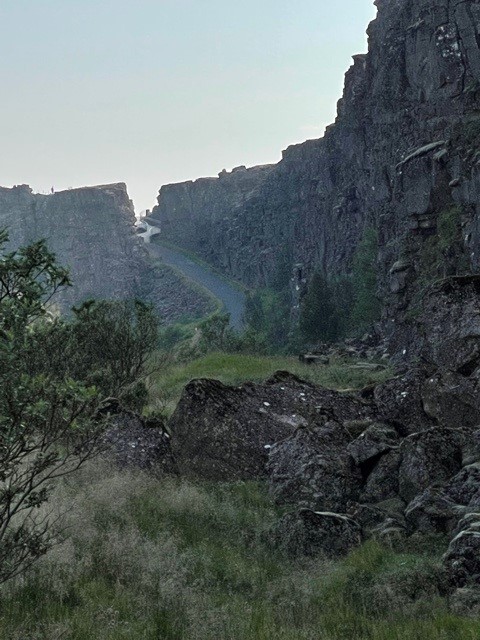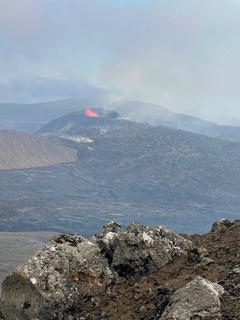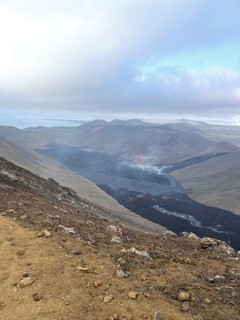First and foremost, do you know what the plural of volcano is? It turns out that it is either volcanos or volcanoes. Either one is correct. What do you know!
You cannot — and I mean cannot — visit Iceland and not be aware of, confronted with, in amazement of the volcanos – emphasis on the “s”.
Iceland does not just have volcanos. They have volcano “systems” – 30 of them. a system might have 5 different calderas, 5 different volcanos. They seem to be everywhere. There are around 130 individual volcanos in Iceland.

The reason of course is the reason that Iceland exists. It sits literally on the ridge that is the meeting point of the Eurasian tectonic plate and the North American tectonic plate. These plates are moving away from each other at a rate of 2 centimeters per year, or approximately 6 feet over 100 years. As the two plates move apart, magma (molten rock) starts rising. All of Iceland is made of volcanic rock.

Iceland has a volcanic eruption on an average every 4 years. An eruption can last for two days, six months or for several years.
Of the many eruptions a few are particularly noteworthy.
- There was the Eyjafjallajokull eruption in 2010 that caused 90,000 flights to be disrupted across the European continent for a week or more.
- More significantly in 1783 there was the Laki eruption which released tons of sulfur dioxide gas up to 50,000 feet in the atmosphere, causing all kinds of global calamities. It caused a drop in global temperatures, which caused crop failures in Europe and may have caused droughts in North Africa and India.
- In my post yesterday about the Westman Islands I recounted the 1973 Eldfell eruption there and what impact it had on that island archipelago.

What is so amazing about today is that there is an eruption occurring as I write this. In fact this morning I was up and starting out on the trail at 8am to see in person the Fagradalsfjall volcano in the Geldingadalur valley on the Reykjanes Peninsula, about 20 miles southwest of Reykjvik. A somewhat challenging 1.5 hour one way hike to a ridge a safe distance away allowed me to see the caldera spewing red fire lava sporadically every few seconds. In the process it created glowing red hot lava rivers winding its way down the terrain from the caldera itself. A truly amazing sight. How many people get the opportunity to see a volcano erupting?

This volcano has been active and erupting since March, over six months. It takes breaks. Now it is active about 10 hours each day, and the rest of the time each day it is quiet. The volcano is surely active, not dormant. You may have seen the recent 60 Minutes segment on this volcano.
You may be asking what is the difference between a volcano and an earthquake. Good question. As I understand it…
before I go any further, let me acknowledge that I have never taken a geology course, nor have I had any science courses like biology or chemistry. I did have an introductory class in physics. I realize that you may be wondering how is this possible in our educational system. Short story is that I was exempted from the sciences because of my years of focus on the study of classical Greek and Latin. But that is a story for another time.
Back to the difference between earthquakes and volcanos. Both involve the earth reminding us of the fragility of our planet. Earthquakes come from the movement of tectonic plates where they come together and rub each other. Volcanos are openings or vents in the earth’s crust that allow gasses and molten lava to escape and at time erupt. An earthquake is an event. A volcano is a location.
Iceland is also the land of earthquakes. Believe it or not, they have about 500 earthquakes each week!! the great majority of course are so small that they are barely felt.
Back to volcanos. And particularly to the Fagradalsfjall volcano that is active today. And I mean today.

You may be asking how did it gets its easy to pronounce and easy to remember name. Icelanders often name new landmarks based on their location, and the Icelandic language allows to combine many words together into one. Fagra, pronounced “Fiera”, means beautiful, Dal means valley and Fjall means mountain. Fagri-dalur is “a beautiful valley,” and the “mountain in the beautiful valley” is the Fagradalsfjall. I told you it would be easy.
All I can say is that I have a newfound appreciation for the power of what is under the ground on this planet that we are lucky enough to live on.
What a science lesson!
I love that in every post I learn something new! Really amazing photos. So lucky to be there right now!
Great lecture on earth science. I did take quite a bit of science during my premed and medical studies. Instead of your choice of languages I studied Scientific German and some Latin..
Neil, Looks like your knee is doing good after your surgery. A 15 hour hike one way-thats a lot. Were you by yourself or with a group. The volcanos are a sight to see-truly amazing. We’ve only seen the Hawaii ones-pretty scary to be near them. Good luck going forward, and enjoy the rest of your trip. We are ensconced in smoke here right now. Till this morning, we were free of smoke-not like the Okanagan. Friends from there are coming to visit to get away from the smoke there, but now it is here too. Its been like that since June already. Stay safe, and healthy.
liz,
the hike was 1.5 miles one way, not 15 miles! the new knee is not that good!
Neil, it’s been a long time since I’ve sat in a classroom, but I’m enjoying your lectures so much more. You may have missed your calling!
Neil, it’s been a long time since I’ve sat in a classroom, but I’m enjoying your lectures so much more. You may have missed your calling!
Good read
Sounds like you really enjoyed Iceland.
We look forward to hearing more first hand later this year
Fascinating once again Neil. You are a great story teller. I find when scrolling my
e-mails, yours is the first opne I open up.